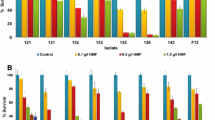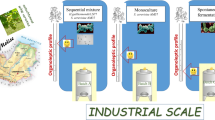Abstract
Present study aimed to ascertain whether the combination of two factors, i.e., time of harvest and type of yeast, can significantly moderate the effect of climate change on Chardonnay wine composition. In this view, three Chardonnay musts obtained from grapes at different harvest date [technological maturity ‘as control’; delayed harvest; a mixture of ‘early (green) harvest’ with delayed harvest ‘as alternative approach’] and three selected yeast strains [Saccharomyces cerevisiae ‘as control’; hybrid Saccharomyces cerevisiae/Saccharomyces paradoxus; scalar alternative approach with Starmerella bacillaris and hybrid Saccharomyces cerevisiae/Saccharomyces paradoxus] were used to design and compare six different trials, replicated at pilot level (n. total fermentations: 18). Wines were evaluated in terms of sensory and chemical parameters (alcohol, acidity, organic acids, phenolic compounds and glycerol) and results tested by statistical analysis. Although the wine alcohol content decreased at the best by ~ 1.2% v/v, whereas the total acidity increased up to ~ 2.5 g/L, the results from sensory evaluation highlighted that the proposed ‘alternative approach’ may cause excessive acidity and bitterness perception, therefore, further deacidification and fining treatments may be needed. The present approach to reduce the alcohol content of wine and increase its total acidity is simple, inexpensive and applicable in all wineries.


Similar content being viewed by others
References
Godden P, Wilkes E, Johnson D (2015) Trends in the composition of Australian wine 1984–2014. Aust J Grape Wine Res 21:741–753
Neumann PA, Matzarakis A (2014) Potential climate change impacts on winegrape must density and titratable acidity in southwest Germany. Clim Res 59:161–172
Petrie PR, Sadras VO (2008) Advancement of grapevine maturity in Australia between 1993 and 2006: putative causes, magnitude of trends and viticultural consequences. Aust J Grape Wine Res 14:33–45
Teslić N, Zinzani G, Parpinello GP, Versari A (2018) Climate change trends, grape production, and potential alcohol concentration in wine from the “Romagna Sangiovese” appellation area (Italy). Theor Appl Climatol 131:793–803
García-Martín N, Perez-Magariño S, Ortega-Heras M, González-Huerta C, Mihnea M, González-Sanjosé ML, Palacio L, Prádanos P, Hernández A (2010) Sugar reduction in musts with nanofiltration membranes to obtain low alcohol-content wines. Sep Purif Technol 76:158–170
Gil M, Estévez S, Kontoudakis N, Fort F, Canals JM, Zamora F (2013) Influence of partial dealcoholization by reverse osmosis on red wine composition and sensory characteristics. Eur Food Res Technol 237:481–488
Duchêne E, Schneider C (2005) Grapevine and climatic changes: a glance at the situation in Alsace. Agronomie 25:93–99
Jones GV (2012) Climate, grapes, and wine: structure and suitability in a changing climate. In: Proc 28th IHC—IS Viti&Climate, Lisbon, Portugal, pp 19–28
Martínez-Lüscher J, Sánchez-Díaz M, Delrot S, Aguirreolea J, Pascual I, Gomès E (2016) Ultraviolet-B alleviates the uncoupling effect of elevated CO2 and increased temperature on grape berry (Vitis vinifera cv. Tempranillo) anthocyanin and sugar accumulation. Aust J Grape Wine Res 22:87–95
Coombe BG (1989) The grape berry as a sink. Acta Hortic 239:149–158
Lakso AN, Kliewer WM (1975) The influence of temperature on malic acid metabolism in grape berries: I. Enzyme responses. Plant Physiol 56:370–372
Jones GV (2006) Past and future impacts of climate change on wine quality. 3rd international wine business research conference, Montpellier, pp 1–16
Belancic A, Agosin E, Ibacache A, Bordeu E, Baumes R, Razungles A, Bayonove C (1997) Influence of sun exposure on the aromatic composition of chilean Muscat grape cultivars Moscatel de Alejandria and Moscatel rosada. Am J Enol Vitic 48:181–186
Allen M, Lacey M (1993) Methoxypyrazine grape flavour: influence of climate, cultivar and viticulture. Die Wein-wissenschaft 48:211–213
Vršič S, Šuštar V, Pulko B, Šumenjak TK (2014) Trends in climate parameters affecting winegrape ripening in northeastern Slovenia. Clim Res 58:257–266
Tomasi D, Jones GV, Giust M, Lovat L, Gaiotti F (2011) Grapevine phenology and climate change: relationships and trends in the Veneto Region of Italy for 1964–2009. Am J Enol Vitic 62:329–339
Ramos MC, Jones GV, Yuste J (2015) Spatial and temporal variability of cv. Tempranillo phenology and grape quality within the Ribera del Duero DO (Spain) and relationships with climate. Int J Biometeorol 59:1849–1860
Frioni T, Tombesi S, Silvestroni O, Lanari V, Bellincontro A, Sabbatini P, Gatti M, Poni S, Palliotti A (2016) Postbudburst spur pruning reduces yield and delays fruit sugar accumulation in Sangiovese in central Italy. Am J Enol Vitic 67:419–425
Palliotti A, Panara F, Silvestroni O, Lanari V, Sabbatini P, Howell GS, Gatti M, Poni S (2013) Influence of mechanical postveraison leaf removal apical to the cluster zone on delay of fruit ripening in Sangiovese (Vitis vinifera L.) grapevines. Aust J Grape Wine Res 19:369–377
Kontoudakis N, Esteruelas M, Fort F, Canals JM, Zamora F (2011) Use of unripe grapes harvested during cluster thinning as a method for reducing alcohol content and pH of wine. Aust J Grape Wine Res 17:230–238
Salgado CM, Fernández-Fernández E, Palacio L, Hernández A, Prádanos P (2015) Alcohol reduction in red and white wines by nanofiltration of musts before fermentation. Food Bioprod Process 96:285–295
Harbertson JF, Mireles MS, Harwood ED, Weller KM, Ross CF (2009) Chemical and sensory effects of saignée, water addition, and extended maceration on high brix must. Am J Enol Vitic 60:450–460
Kutyna DR, Varela C, Henschke PA, Chambers PJ, Stanley GA (2010) Microbiological approaches to lowering ethanol concentration in wine. Trends Food Sci Technol 21:293–302
Contreras A, Hidalgo C, Henschke PA, Chambers PJ, Curtin C, Varela C (2014) Evaluation of non-Saccharomyces yeasts for the reduction of alcohol content in wine. Appl Environ Microbiol 80:1670–1678
Gobbi M, Comitini F, Domizio P, Romani C, Lencioni L, Mannazzu I, Ciani M (2013) Lachancea thermotolerans and Saccharomyces cerevisiae in simultaneous and sequential co-fermentation: a strategy to enhance acidity and improve the overall quality of wine. Food Microbiol 33:271–281
Diban N, Athes V, Bes M, Souchon I (2008) Ethanol and aroma compounds transfer study for partial dealcoholization of wine using membrane contactor. J Memb Sci 311:136–146
EC (1990) Commission regulation (EC) No 2676/90 of 17 September 1990 determining community methods for the analysis of wines. Off J Eur Commun 272:64–73
Castellari M, Versari A, Spinabelli U, Galassi S, Amati A (2000) Method for the analysis of organic acids, carbohydrates and alcohols in grape musts. J Liq Chromatogr Relat Technol 23:2047–2056
Singleton VL, Rossi JA (1965) Colorimetry of total phenolics with phosphomolybdic-phosphotungstic acid reagents. Am J Enol Vitic 16:144–158
Lawless HT, Heymann H (2010) Sensory evaluation of food: principles and practices, 2nd edn. Springer-Verlag, New York
ISO (1977) Sensory analysis—apparatus—wine tasting glass. International Organization for Standardization, Geneva
Boulton RB, Singleton VL, Bisson LF, Kunkee RE (1999) Principles and practices of winemaking. Springer, New York
Orlic S, Redzepovic S, Jeromel A, Herjavec S, Iacumin L (2007) Influence of indigenous Saccharomyces paradoxus strains on Chardonnay wine fermentation aroma. Int J Food Sci Technol 42:95–101
Romboli Y, Mangani S, Buscioni G, Granchi L, Vincenzini M (2015) Effect of Saccharomyces cerevisiae and Candida zemplinina on quercetin, vitisin A and hydroxytyrosol contents in Sangiovese wines. World J Microbiol Biotechnol 31:1137–1145
Giaramida P, Ponticello G, Di Maio S, Squadrito M, Genna G, Barone E, Scacco A, Corona O, Amore G, Di Stefano R, Oliva D (2013) Candida zemplinina for production of wines with less alcohol and more glycerol. S Afr J Enol Vitic 34:204–211
Varela C, Sengler F, Solomon M, Curtin C (2016) Volatile flavour profile of reduced alcohol wines fermented with the non-conventional yeast species Metschnikowia pulcherrima and Saccharomyces uvarum. Food Chem 209:57–64
Englezos V, Rantsiou K, Cravero F, Torchio F, Ortiz-Julien A, Gerbi V, Rolle L, Cocolin L (2016) Starmerella bacillaris and Saccharomyces cerevisiae mixed fermentations to reduce ethanol content in wine. Appl Microbiol Biotechnol 100:5515–5526
Pérez-Torrado R, Oliveira BM, Zemančková J, Sychrová H, Querol A (2016) Alternative glycerol balance strategies among Saccharomyces species in response to winemaking stress. Front Microbiol 7:1–13
Noble AC, Bursick GF (1984) The contribution of glycerol to perceived viscosity and sweetness in white wine. Am J Enol Vitic 35:110–112
Laguna L, Bartolomé B, Moreno-Arribas MV (2017) Mouthfeel perception of wine: oral physiology, components and instrumental characterization. Trends Food Sci Technol 59:49–59
Cejudo-Bastante MJ, Hermosín-Gutiérrez I, Castro-Vázquez LI, Pérez-Coello MS (2011) Hyperoxygenation and bottle storage of Chardonnay white wines: effects on color-related phenolics, volatile composition, and sensory characteristics. J Agric Food Chem 59:4171–4182
Olejar KJ, Fedrizzi B, Kilmartin PA (2016) Enhancement of Chardonnay antioxidant activity and sensory perception through maceration technique. LWT Food Sci Technol 65:152–157
Redzepovic S, Orlic S, Majdak A, Kozina B, Volschenk H, Viljoen-Bloom M (2003) Differential malic acid degradation by selected strains of Saccharomyces during alcoholic fermentation. Int J Food Microbiol 83:49–61
Torrea D, Varela C, Ugliano M, Ancin-Azpilicueta C, Leigh Francis I, Henschke PA (2011) Comparison of inorganic and organic nitrogen supplementation of grape juice—effect on volatile composition and aroma profile of a Chardonnay wine fermented with Saccharomyces cerevisiae yeast. Food Chem 127:1072–1083
OIV (2016) Compendium of international methods of wine and must analysis, 1st edn. International Organisation of vine and wine, Paris
Wang XQ, Su HN, Zhang QH, Yang PP (2013) The effects of pulsed electric fields applied to red and white wines during bottle ageing on organic acid contents. J Food Sci Technol 52:171–180
Pan W, Jussier D, Terrade N, Yada RY, Mira de Orduña R (2011) Kinetics of sugars, organic acids and acetaldehyde during simultaneous yeast-bacterial fermentations of white wine at different pH values. Food Res Int 44:660–666
Kliewer WM, Howarth L, Omori M (1967) Concentrations of tartaric acid and malic acids and their salts in Vitis Vinifera grapes. Am J Enol Vitic 18:42–54
Sadoudi M, Tourdot-Maréchal R, Rousseaux S, Steyer D, Gallardo-Chacón JJ, Ballester J, Vichi S, Guérin-Schneider R, Caixach J, Alexandre H (2012) Yeast-yeast interactions revealed by aromatic profile analysis of Sauvignon Blanc wine fermented by single or co-culture of non-Saccharomyces and Saccharomyces yeasts. Food Microbiol 32:243–253
Coulter A, Godden P, Isak P (2004) Succinic acid—how is it formed, what is its effect on titratable acidity, and what factors influence its concentration in wine? Wine Ind J 19:16–25
Arikawa Y, Kobayashi M, Kodaira R, Shimosaka M, Muratsubaki H, Enomoto K, Okazaki M (1999) Isolation of sake yeast strains possessing various levels of succinate- and/or malate-producing abilities by gene disruption or mutation. J Biosci Bioeng 87:333–339
Thoukis G, Ueda M, Wright D (1965) The formation of succinic acid during alcoholic fermentation. Am J Enol Vitic 16:1–8
Shimazu Y, Watanabe M (1981) Effects of yeast strains and environmental conditions on formation of organic acids in must during fermentation. J Ferment Technol 59:27–32
Chamkha M, Cathala B, Cheynier V, Douillard R (2003) Phenolic composition of champagnes from Chardonnay and Pinot Noir vintages. J Agric Food Chem 51:3179–3184
Ong BY, Nagel CW (1978) Hydroxycinnamic acid-tartaric acid ester content in mature grapes and during the maturation of white Riesling grapes. Am J Enol Vitic 29:277–281
Adams DO (2006) Phenolics and ripening in grape berries. Am J Enol Vitic 57:249–256
Acknowledgements
The first author acknowledges staff from the Interdepartmental Centre for Industrial Research Energy and Environment, the Interdepartmental Center for Industrial Agri-Food Research and the Faculty of BioScience and Technology for Food, Agriculture and Environment for their contribution. The first author acknowledges the Erasmus Mundus JoinEU-SEE PENTA program and the Fund for young talents of the Republic of Serbia for the PhD fellowship.
Author information
Authors and Affiliations
Corresponding author
Ethics declarations
Conflict of interest
The authors declare no conflict of interest.
Human and animal right statement
This article does not contain any studies with human or animal subjects.
Electronic supplementary material
Below is the link to the electronic supplementary material.
Rights and permissions
About this article
Cite this article
Teslić, N., Patrignani, F., Ghidotti, M. et al. Utilization of ‘early green harvest’ and non-Saccharomyces cerevisiae yeasts as a combined approach to face climate change in winemaking. Eur Food Res Technol 244, 1301–1311 (2018). https://doi.org/10.1007/s00217-018-3045-0
Received:
Revised:
Accepted:
Published:
Issue Date:
DOI: https://doi.org/10.1007/s00217-018-3045-0




